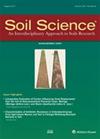油棕管理改变了表土中无定形二氧化硅和流动硅的空间分布
4区 农林科学
Q2 Agricultural and Biological Sciences
引用次数: 3
摘要
摘要油棕管理对小农油棕人工林硅循环的影响研究甚少。由于油棕是硅的蓄积物,我们假设管理措施和表土侵蚀可能导致油棕种植下表土硅的损失和空间硅浓度格局的变化。为了验证这一假设,我们在印度尼西亚占壁省排水良好的河岸地区的成熟油棕种植园下采集了表土样本。样本取自每个油棕地块内的四个不同管理区域:油棕圈、油棕行、油棕行间和叶桩下方。我们分别通过萃取CaCl2和NaCO3来量化可移动硅(SiM)和非晶二氧化硅(SiAm)中的硅。两者都是土壤中重要的硅库,对植物-土壤硅循环至关重要。我们进一步在排水良好的倾斜油棕种植园安装了沉积物收集器,以估计每年因侵蚀造成的土壤和暹罗的损失。在排水良好的地区,与棕榈圈(1.71±0.35 mg g−1)、油棕行(1.87±0.51 mg g−1)和行间(1.88±0.39 mg g−1)相比,前桩下的平均表土SiAm浓度(3.97±1.54 mg g−1)显著高于前桩下(3.97±1.54 mg g−1)。在河岸地区,平均表层土壤SiAm浓度最高的区域还包括树桩下方(2.96±0.36 mg g - 1)和草覆盖行间(2.71±0.13 mg g - 1),而棕榈圈表层土壤SiAm浓度则低得多(1.44±0.55 mg g - 1)。我们将叶桩下表层土壤和草覆盖的交错层中的高暹罗浓度归因于腐烂的油棕叶、草和莎草释放的植石。在棕榈圈(在排水良好的地区和河岸地区)、油棕行和无植被的行间(仅在排水良好的地区),SiAm浓度显著降低的原因是这些管理区域缺乏凋落物的回归。表层土壤simm平均浓度在~ 10 ~ 20µg g−1之间。它们往往在河岸地区较高,但在排水良好的地区和河岸地区之间的差异没有统计学意义。基于侵蚀陷阱的土壤流失量计算证实,在斜坡上的油棕丛丛中,表层土壤侵蚀相当严重。侵蚀估计在4-6毫克公顷−1年−1之间,其中SiAm损失在5-9公斤−1公顷−1年−1之间。基于观察到的Si空间格局,我们得出结论,小农可以通过(1)保持油棕行间的草覆盖,(2)将油棕凋落物纳入人工林管理,(3)防止土壤压实和表壳形成,有效地减少系统内的侵蚀和支持Si循环。本文章由计算机程序翻译,如有差异,请以英文原文为准。
Oil-palm management alters the spatial distribution of amorphous silica and mobile silicon in topsoils
Abstract. Effects of oil-palm (Elaeis guineensis Jacq.) management on silicon (Si) cycling under smallholder oil-palm plantations have hardly been investigated. As oil palms are Si accumulators, we hypothesized that management practices and topsoil erosion may cause Si losses and changes in spatial Si concentration patterns in topsoils under oil-palm cultivation. To test this hypothesis, we took topsoil samples under mature oil-palm plantations in well-drained and riparian areas of Jambi Province, Indonesia. The samples were taken from four different management zones within each oil-palm plot: palm circles, oil-palm rows, interrows, and below frond piles. We quantified mobile Si (SiM) and Si in amorphous silica (SiAm) by the extraction of CaCl2 and NaCO3, respectively. Both fractions are important Si pools in soils and are essential for plant–soil Si cycling. We further installed sediment traps on sloping, well-drained oil-palm plantations to estimate the annual loss of soil and SiAm caused by erosion. In well-drained areas, mean topsoil SiAm concentrations were significantly higher below frond piles (3.97 ± 1.54 mg g−1) compared to palm circles (1.71 ± 0.35 mg g−1), oil-palm rows (1.87 ± 0.51 mg g−1), and interrows (1.88 ± 0.39 mg g−1). In riparian areas, the highest mean topsoil SiAm concentrations were also found below frond
piles (2.96 ± 0.36 mg g−1) and in grass-covered interrows (2.71 ± 0.13 mg g−1), whereas topsoil SiAm concentrations of palm circles were much lower (1.44 ± 0.55 mg g−1). We attributed the high SiAm concentrations in topsoils under frond piles and in grass-covered interrows to phytolith release from decaying oil-palm fronds, grasses, and sedges. The significantly lower SiAm concentrations in palm circles (in both well-drained and riparian areas), oil-palm rows, and unvegetated interrows (only in well-drained areas) were explained by a lack of litter return to these management zones. Mean topsoil SiM
concentrations were in the range of ∼ 10–20 µg g−1. They tended to be higher in riparian areas, but the differences between well-drained and riparian sites were not statistically significant.
Soil-loss calculations based on erosion traps confirmed that topsoil erosion was considerable in oil-palm interrows on slopes. Erosion estimates were in the range of 4–6 Mg ha−1 yr−1, involving SiAm losses in a range of 5–9 kg−1 ha−1 yr−1. Based on the observed spatial
Si patterns, we concluded that smallholders could efficiently reduce erosion and support Si cycling within the system by (1) maintaining a grass cover in oil-palm rows and interrows, (2) incorporating oil-palm litter into plantation management, and (3) preventing soil compaction and surface-crust formation.
求助全文
通过发布文献求助,成功后即可免费获取论文全文。
去求助
来源期刊

Soil Science
农林科学-土壤科学
CiteScore
2.70
自引率
0.00%
发文量
0
审稿时长
4.4 months
期刊介绍:
Cessation.Soil Science satisfies the professional needs of all scientists and laboratory personnel involved in soil and plant research by publishing primary research reports and critical reviews of basic and applied soil science, especially as it relates to soil and plant studies and general environmental soil science.
Each month, Soil Science presents authoritative research articles from an impressive array of discipline: soil chemistry and biochemistry, physics, fertility and nutrition, soil genesis and morphology, soil microbiology and mineralogy. Of immediate relevance to soil scientists-both industrial and academic-this unique publication also has long-range value for agronomists and environmental scientists.
 求助内容:
求助内容: 应助结果提醒方式:
应助结果提醒方式:


